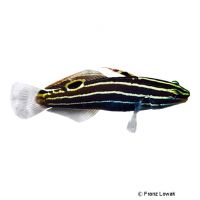Hector’s Goby (Koumansetta hectori)
| Hector’s Goby Koumansetta hectori | |
|---|---|
| Name | Hector’s Goby |
| Name Lat. | Koumansetta hectori |
| Synonym | Amblygobius hectori |
| Family | Gobies |
| Family lat. | Gobiidae |
| Order | Gobies |
| Order lat. | Gobiiformes |
| Origin | Indo-West Pacific, Red Sea |
| Habitat | Lagoons, coral reefs |
| Diet | Omnivore |
| pH | 8.1-8.4 |
| Hardness | 8-10 °KH |
| Behavior | Peaceful |
| Keeping | Individual, group |
| Reef Compatible | Yes |
| Care Level | Difficult |
| Life Span | 6-8 years |
| Protection | No |
| Metric Units | |
| Size | 8 cm |
| Temperature | 22-28 °C |
| Salinity | 33-36 ‰ |
| Aquarium | ~ 200 l |
| US Units | |
| Size | 3" |
| Temperature | 72-82 °F |
| Salinity | 1.020-1.025 sg |
| Aquarium | ~ 50 gal |
Distribution and habitat
The range of Koumansetta hectori extends from the Red Sea and East African coast to Indonesia and from southern Japan to the Great Barrier Reef. They live in sheltered sandy lagoons and on inner reefs where they like to stay under large coral reefs.
Maintenance
They need an aquarium with a reef structure that offers numerous hiding, resting and covering possibilities, with living stones that act like a biological filter and free sand areas with a graveable, at least 6 cm deep substrate of fine to medium coral sand
Only calcareous, heavy metal-free sands, gravels, stones or sea sand of various grain sizes may be used as substrate. Filters, skimmers and heaters are necessary to ensure water quality, as well as pumps to simulate tides, swells and bottom currents. Lighting must correspond to the species-appropriate day-night rhythm of the animals
| Salinity: 33-36 ‰ | pH value: 8.1-8.4 |
| Carbonate hardness: 8-10 °KH | Nitrate content: 2-8 mg/l |
| phosphate content: 0.01-0.1 mg/l | nitrite content: 0.0-0.05 mg/l |
For salinity, an average value should be aimed for, which may only vary slightly by +/- 0.5 ‰. Ammonia and ammonium must not be measurable. Special attention must be paid to constantly good water quality.
Diet
In nature they feed mainly on zooplankton and algae. The food change does not always succeed without problems. The food supply should consist of a combination of live and frozen food, such as small mysis, artemia, bosmids and cyclops, or a commercially available, vitamin-enriched, frozen food mix for plankton eaters. In addition, they need plenty of algae as food (nori algae). High-quality flake and granulated food on a vegetable basis (spirulina, kelp) is also often accepted after a period of acclimatization. It is recommended to feed small portions several times a day. Regular and varied feeding promotes health and increases resistance.
Behaviour and compatibility
Koumansetta hectori should be kept individually. They behave territorially, so keeping several animals is only recommended in a larger and richly structured tank. They can be well socialized with other fish
Sex dimorphism
There are no known external distinguishing characteristics.
Reproduction and breeding
There are no known reports of successful breeding in the aquarium.
Important
They eat the algae growth and sift the sand for microorganisms. Some also pluck at filamentous algae
The aquarium should be well covered, because they are skittish and like to jump.
If different species are kept together, make sure that the fish match each other in terms of water quality and temperature requirements, as well as their social behavior, and that the setup meets the needs of all species kept together. Newly introduced fish must be acclimated slowly to the water in the aquarium
Further literature can be found in your pet store.
References
Text: Werner Winter; Image: Franz Lowak
Source: KUITER, DEBELIUS (2007): Atlas der Meeresfische: Die Fische an den Küsten der Weltmeere, Kosmos Verlag; BAENSCH & DEBELIUS (2006): Meerwasser Atlas Bd. 1, Mergus Verlag; ENGELMANN (2005): Zootierhaltung - Tiere in menschlicher Obhut: Fische, Verlag Harri Deutsch
- Gemäß § 21 Abs. 5 Tierschutzgesetz idgF
